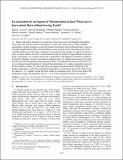Ice nucleation by surrogates of Martian mineral dust: What can we learn about Mars without leaving Earth?
Author(s)
Cziczo, Daniel James; Garimella, Sarvesh; Raddatz, Michael; Hoehler, Kristina; Schnaiter, Martin; Saathoff, Harald; Moehler, Ottmar; Abbatt, Jonathan P. D.; Ladino, Luis A.; ... Show more Show less
Downloaddan 9jgre20155.pdf (657.5Kb)
PUBLISHER_POLICY
Publisher Policy
Article is made available in accordance with the publisher's policy and may be subject to US copyright law. Please refer to the publisher's site for terms of use.
Terms of use
Metadata
Show full item recordAbstract
Water and carbon dioxide ice clouds have been observed in the Martian atmosphere where they are dynamic parts of that planet's water and carbon cycles. Many Martian atmospheric models struggle to correctly predict clouds and, with insufficient data, some use untested simplifications that cloud formation occurs exactly at the saturation point of the condensed phase or at the same conditions as terrestrial cirrus clouds. To address the lack of data, we have utilized an 84 m3 cloud chamber built for studies of high altitude cirrus and polar stratospheric ice clouds in the Earth's atmosphere and adapted to Martian conditions. Using this chamber, we have been able to produce water ice clouds from aerosol in an inert and low pressure atmosphere mimicking that of Mars. At temperatures between 189 and 215 K, we investigated cloud formation by mineral dust particulates of a similar composition and size to those found on Mars. We show that these surrogate materials nucleate effectively at the higher temperatures, with minor temperature dependence at saturations ratios with respect to the ice phase of ~1.1, similar to what has been found for terrestrial cirrus. At the lower end of the temperature range, this saturation rises to ~1.9, a result consistent with previous studies.
Date issued
2013-09Department
Massachusetts Institute of Technology. Department of Earth, Atmospheric, and Planetary SciencesJournal
Journal of Geophysical Research: Planets
Publisher
American Geophysical Union
Citation
Cziczo, Daniel J., Sarvesh Garimella, Michael Raddatz, Kristina Hoehler, Martin Schnaiter, Harald Saathoff, Ottmar Moehler, Jonathan P. D. Abbatt, and Luis A. Ladino. “Ice Nucleation by Surrogates of Martian Mineral Dust: What Can We Learn About Mars Without Leaving Earth?” Journal of Geophysical Research: Planets 118 (September 2013): 1945-1954. ©2013. American Geophysical Union.
Version: Final published version
ISSN
21699097